Imagine turning every customer interaction into a moment of delight and a driver of growth. That’s what happens when you put your customers’ needs before your own.
While many companies claim they focus on their buyers, customer-oriented ones make it happen, standing head and shoulders above the competition.
In this article, you’ll discover what customer orientation means and why it’s crucial for small businesses. You’ll also learn how to take action through a five-step roadmap for becoming customer-oriented in 90 days or less.
Customer orientation definition: putting your customers’ needs, expectations and goals at the heart of every business strategy decision – including product development, marketing campaigns, sales efforts and customer service.
Instead of focusing on sales principles, companies build products, services and experiences around customer pain points.
For example, a software company that embraces the customer-oriented meaning and mindset solicits requests from clients rather than guessing what customers want. It incorporates the best ideas into its product roadmap and works with users to perfect the features.
There are various ways a business can showcase its customer orientation competency, such as:
Basing all decision-making around customer needs
Automated feedback systems that collect customer opinions
Consistent and personalized touchpoints
Marketing campaigns centered around customers
Customer orientation enables companies to shift from competing solely on pricing strategy or product features to the overall customer experience (CX). It’s a particularly clever strategy for small businesses that lack the resources or market capture to offer the lowest retainer or most comprehensive product.
It’s also a sensible approach for organizations that rely on repeat business. The more customer-oriented you are, the easier it is to delight your audience by creating memorable experiences that increase customer loyalty.
At this point, you may wonder what distinguishes customer orientation from customer centricity. You’ll learn about that next.
What’s the difference between customer centricity and customer orientation?
Some guides define customer orientation and customer centricity differently. They argue that customer orientation focuses on meeting immediate customer needs primarily through exceptional customer service, while customer centricity is more holistic.
Such a distinction places too much emphasis on customer service orientation that goes the extra mile.
While customer service skills like problem-solving, active listening, adaptability and effective communication are essential, your customer orientation efforts should span the entire company.
There are plenty of opportunities to prove you’re customer-oriented before people pick up the phone to call one of your sales reps or fill in your contact form.
So, rather than getting bogged down in semantics, take actionable steps to focus more on your customers’ needs. It will yield all of the business benefits this article explores next.
Download our customer journey map template
What are the benefits of customer orientation?
Homing in on your customers’ preferences, needs and goals is one of the fastest ways to transform the customer experience. You can expect a better brand reputation, higher retention rates and more revenue as a result.
Here are more details on the benefits that customer-oriented companies can reap.
Stand out from competitors
Creating a customer-oriented culture helps your brand develop a competitive moat that rivals will struggle to cross.
While other companies can offer similar price points and features, they can’t replicate what it’s like to use your product or speak to your customer service team. It’s why the majority (80%) of organizations expect to compete mainly on CX moving forward.
This customer-led approach allows small businesses to compete against much larger brands. You might not have the resources to offer the lowest prices, but nothing stops you from providing the best experience.
Exceed customer expectations
Obsessing about your customers lets you solve their needs quickly and effectively, delivering a customer experience (CX) that exceeds their expectations.
A standout customer experience can mean the difference between winning and losing business. 73% of customers say it’s the third most crucial purchasing decision factor behind price and product quality.
CX is beneficial in healthcare settings, as well as in consumer retail and finance sectors:
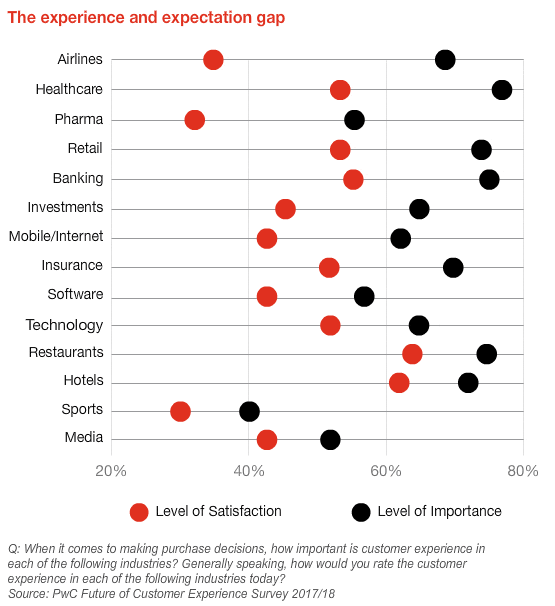
Customer orientation also helps you close the customer experience gap – the difference between what brands think they deliver and what buyers experience.
While over half (51%) of marketers feel they provide an excellent customer experience, only 26% of consumers agree. With customer-oriented services, you ensure you’re in the competitive minority of brands that give people what they want.
Boost customer retention rates
Long-term customer loyalty and retention rates increase when your buyer base believes your business genuinely cares about them.
Research by Forrester says customers are 2.4 times more likely to stick with a brand that solves their pain points quickly. If you exceed customer expectations, fix their problems and help them achieve their goals, they’ll have no reason to go elsewhere.
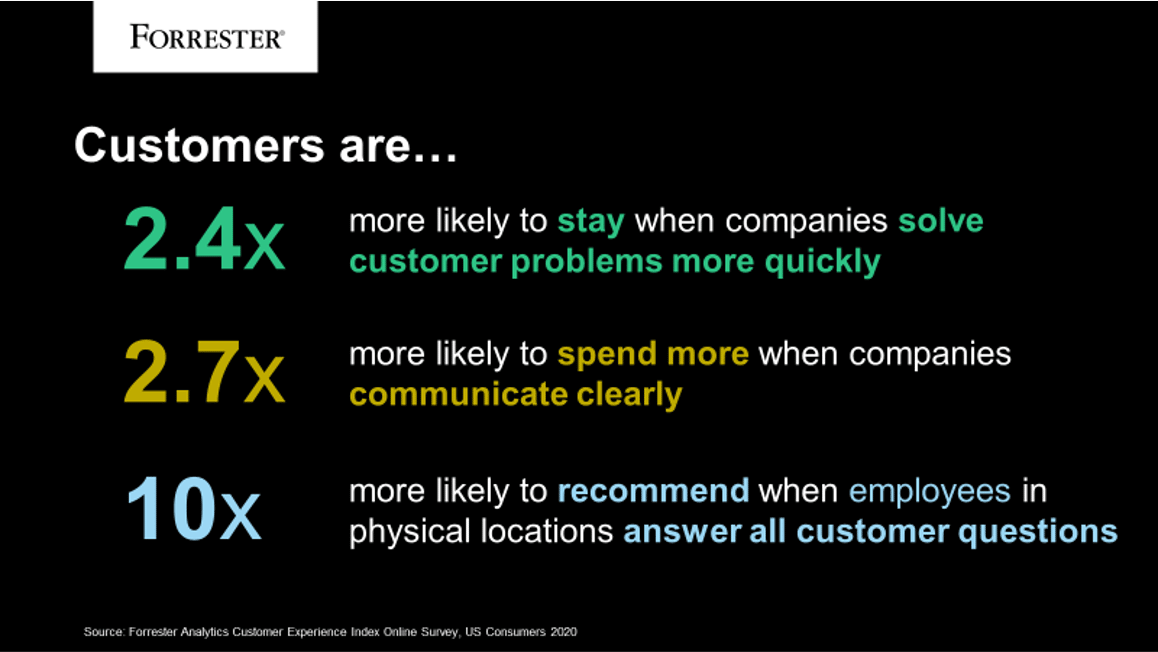
Additional research from Forrester’s 2024 US Customer Experience Index found that customer-obsessed organizations have 51% higher customer retention rates than their peers.
Solid customer orientation means more frequent repeat purchases for e-commerce stores, lower churn rates for SaaS brands and higher customer lifetime values (CLV) overall. It also means bigger profits, all things being equal.
Drive higher profits
Loyal customers purchase more products, resulting in increased revenue and higher profits. According to a Gladly survey, 72% will spend more with brands that ensure excellent customer experiences.
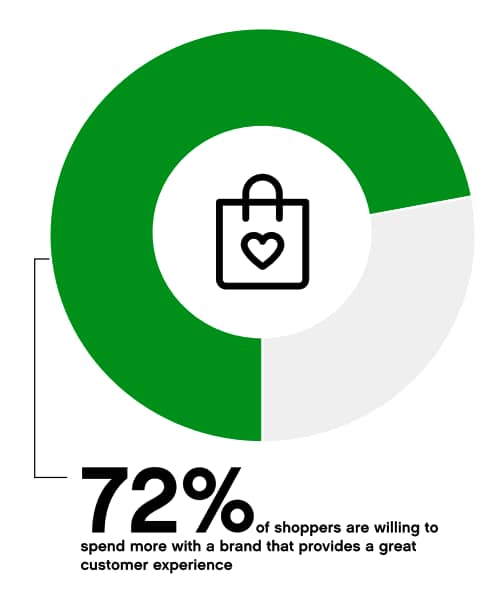
Forrester’s 2024 Customer Experience Index also found that 41% of customer-obsessed companies achieved at least 10% revenue growth in their last fiscal year, compared to just 10% of less mature companies.
Word-of-mouth marketing is a major contributor to revenue growth, with research showing it’s the main factor behind 20% to 50% of all purchasing decisions. Satisfied customers are more likely to tell their friends and contacts about a brand, meaning you get sales referrals and higher retention rates.
Far from hurting your company’s bottom line, focusing on customers instead of sales can increase long-term profitability.
How to become a customer-oriented company in 90 days or less
Becoming a customer-oriented business requires company-wide buy-in, a dedicated strategy and hard work. The good news is that it can happen faster than most think.
Below are five steps to become much more customer-focused this quarter.
1. Start by discovering what your customers think
A customer-oriented approach starts with knowing what your customer base thinks and wants. Build a voice of the customer program to learn what’s important to them and how you can improve your product or service.
A voice of the customer program is a structured way to collect and act on customer complaints and feedback. It stops you from making assumptions, fixing problems that don’t exist and falling short of customer expectations.
There are various ways to collect customer feedback, including:
Pop-up surveys on your website
Automated email campaigns
Personalized requests from sales and customer support teams
Dedicated customer satisfaction tools like Survey Sparrow and Postcall (more on these later)
If you gather feedback using multiple methods, you’ll want to store it in one place for easy access. Your customer relationship management (CRM) software is a handy option as it lets you track responses alongside other customer interactions.
Here’s what a customer feedback tracker looks like in Pipedrive:
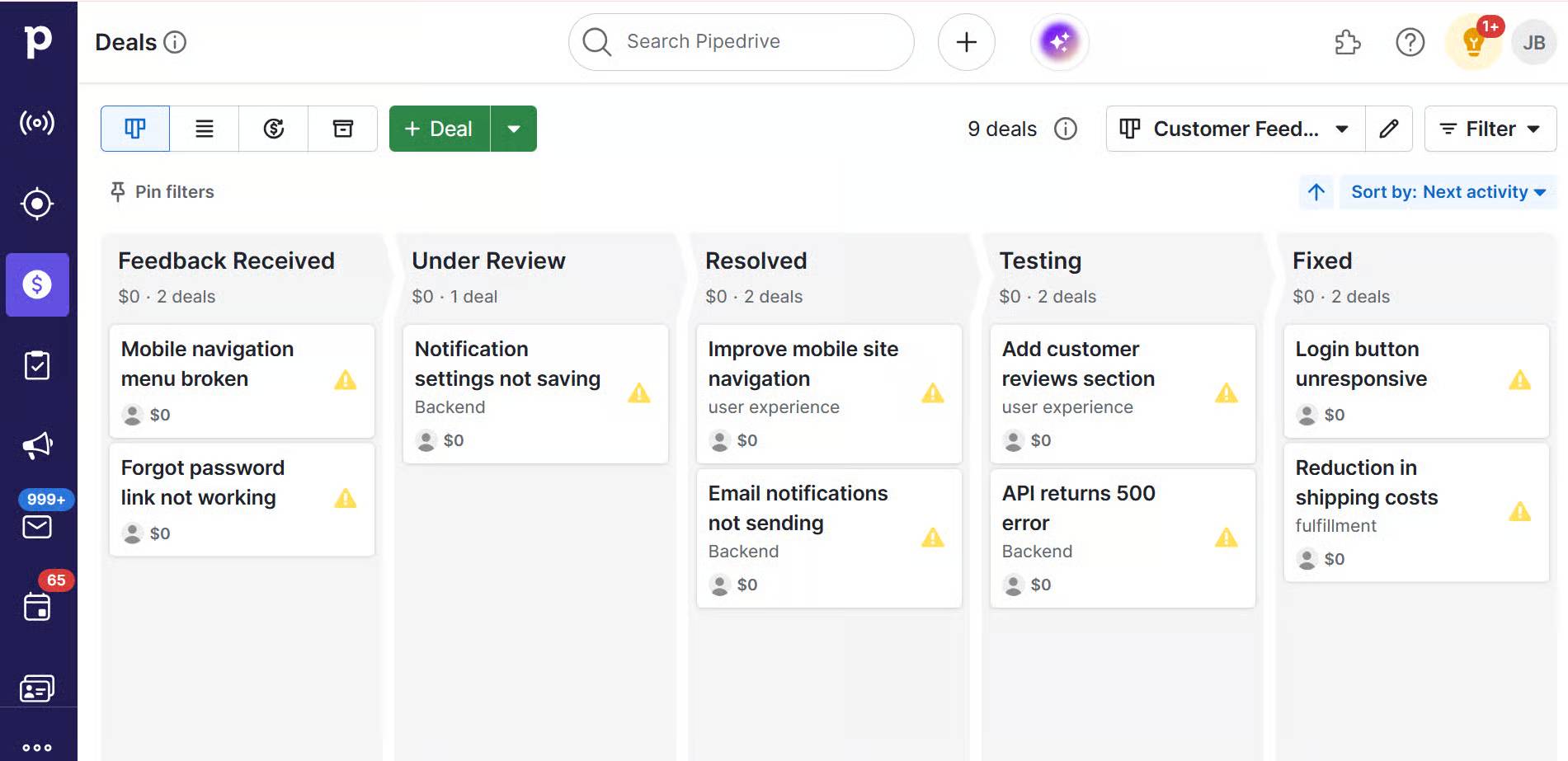
Once you centralize all feedback, review it regularly to find ways to make your product or service more customer-focused. Prioritize ideas according to ease and impact, then implement them one at a time.
Note: Gather customer feedback monthly or quarterly to monitor the impact of your customer orientation strategies. Use historical data to benchmark your performance, looking for improvements in customer service report metrics like CSAT, NPS, CES and retention rates.
2. Use a CRM to centralize customer data
Creating a single source of truth for customer data makes it easy to track customer sentiment, spot trends and use data to improve the experience – whether informing a product roadmap or creating a new support channel.
A CRM is the ideal customer data management tool. It helps you store, analyze and leverage customer information, including contact details and interactions with your sales team.
A CRM platform provides a 360-degree view of every customer. Here’s what that visibility looks like in Pipedrive:
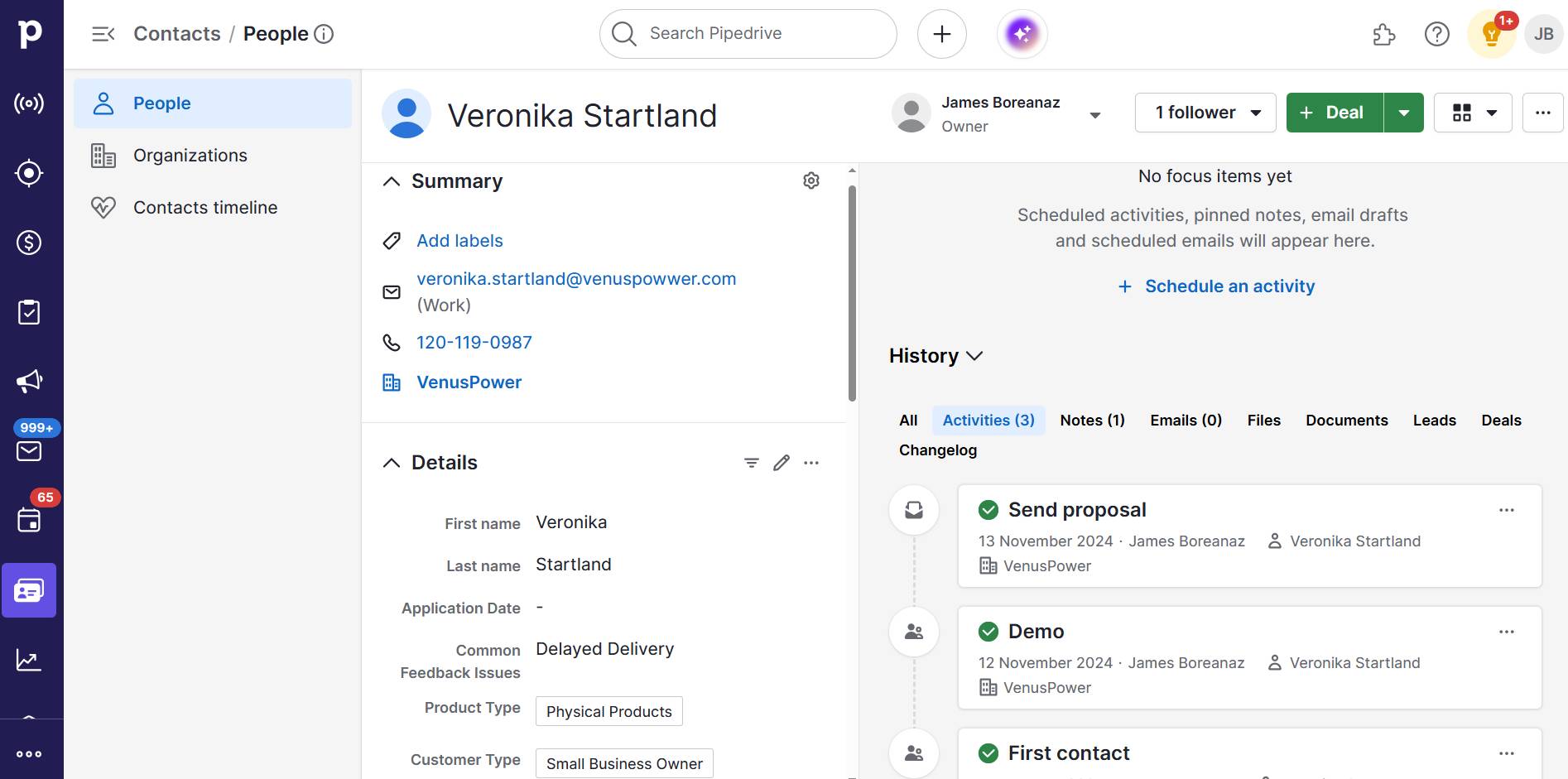
For instance, the knowledge base software company Document360 uses Pipedrive to centralize information from every customer interaction, increasing knowledge flow and eliminating silos.
As Saravana Kumar, CEO of the parent company Kovai.co, explains:
A good CRM will hold more than just contact information. For example, Pipedrive stores purchase history, feedback notes, preferences and support tickets. For small businesses, where teams wear many hats, this centralization saves time and reduces costly miscommunication.
Solar panel installer Sun4power combines Pipedrive Projects and several integrations to automate the flow of customer information and make updates as soon as anything changes. It allows a small team to serve hundreds of customers without letting service levels slip.
Here’s how founder Paul de Bruyne sums up Pipedrive’s customer-oriented functionality:
Use pre-built integrations to automate importing customer data from various tools. Search Pipedrive’s Marketplace to find connections with the following tools and more:
You can use Pipedrive as your all-in-one CRM solution for $14 per user, per month when billed annually. If you want to consider alternatives, make sure you look for a CRM with the following core features:
CRM feature | What to look for |
Contact management | Robust tools for managing contacts, scoring leads and tracking interactions will help you centralize customer information. |
Sales pipeline management | Customizable pipelines that visualize deal progress and help teams manage follow-ups. |
Automation and AI | Automated workflows, lead assignments and email triggers that save time on repetitive tasks and enhance personalization efforts. |
Integrations | Seamless connections with other business applications to centralize data. |
User experience | An intuitive and accessible interface that improves adoption, reduces training time and boosts user productivity. |
Support and training | A wide range of vendor support options, training resources and implementation assistance to facilitate smooth onboarding and rapid adoption. |
Reporting and analytics | Custom reports and forecasting tools that enable data-driven decisions and continuous improvement. |
Ensure that everyone in your organization can access whichever CRM you choose. The goal is to create a complete customer journey history so that every team member contributes – from marketing to frontline support.
3. Use AI to personalize every interaction
Customers have come to expect personalized experiences, so leverage artificial intelligence (AI) to deliver meaningful, relevant interactions at every stage of the sales cycle.
Imagine a customer receiving a welcome email referencing a specific feature they mentioned during a sales call. Or consider a support message that proactively includes a tutorial based on their usage history. These touches show customers that your business sees them as individuals.
Incorporating generative AI into your messaging is an easy way to personalize interactions at scale. For example, Pipedrive’s AI email writer uses CRM data to create relevant, professional emails from short prompts:
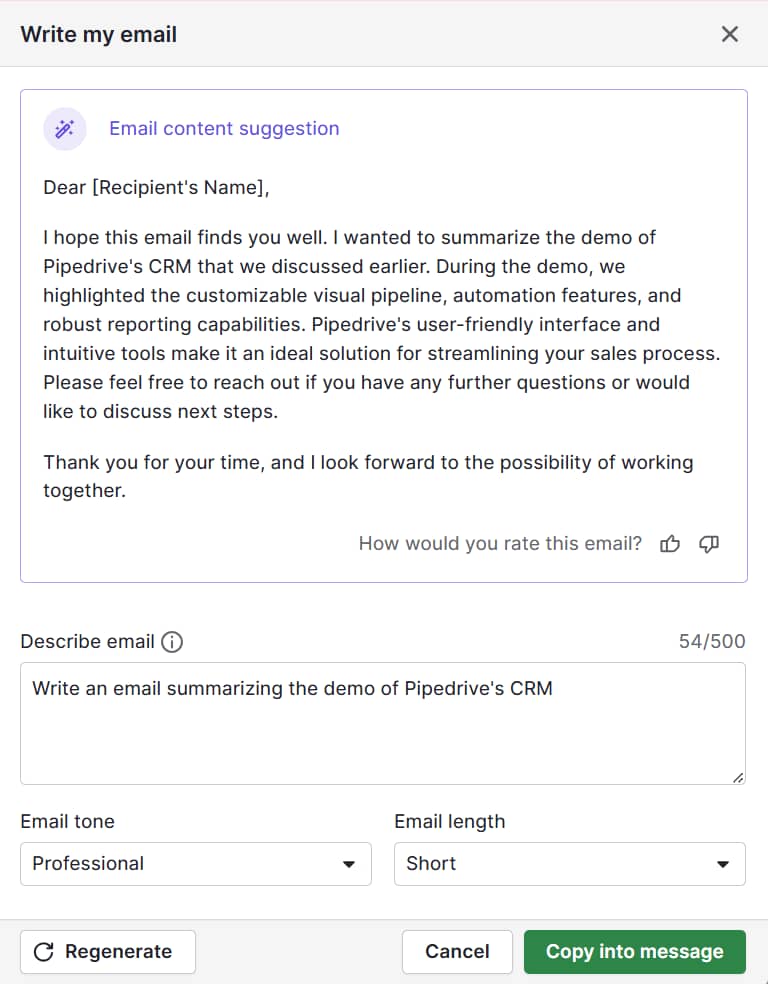
Use the tool to respond to an initial query, create a follow-up email addressing specific pain points mentioned in a previous call or summarize the customer’s needs ahead of closing a deal.
You can choose the tone and length of the email yourself or use Pipedrive’s recommendations to ensure that every email aligns with your brand voice.
Using artificial intelligence in this way helps small businesses level the playing field with larger competitors. You don’t need to hire more salespeople or support staff to deliver a personalized experience when you can harness AI power instead.
4. Improve the hand-off between sales and support
Customers hate repeating themselves, so eliminate frustration by improving handovers between sales and support. A strong handover process removes departmental silos and provides each team with the necessary information to personalize the customer experience and follow up efficiently.
A handover management checklist makes sure nothing gets missed. Include the following key details:
Customer profile and contact information
Goals and expectations
Challenges and previous solutions
Preferred product features
Open questions and unresolved issues
Agreed upon next steps
A solid handover means customers find value faster. Support can focus on the use cases that your audience cares about, increasing customer satisfaction, engagement and retention.
5. Implement self-service customer support
Self-service support tools give existing customers the freedom to resolve their own problems without speaking to a customer service rep.
By providing easy-to-use self-service tools like knowledge bases and customer portals, you empower people who want to self-serve while freeing up your support team to focus on more complex queries.
For example, Pipedrive has an in-depth knowledge base, webinars, video tutorials and a blog that helps users find answers to their questions and learn how to operate the software.
The knowledge base has a clear, scannable format with a search bar that helps customers quickly find answers.
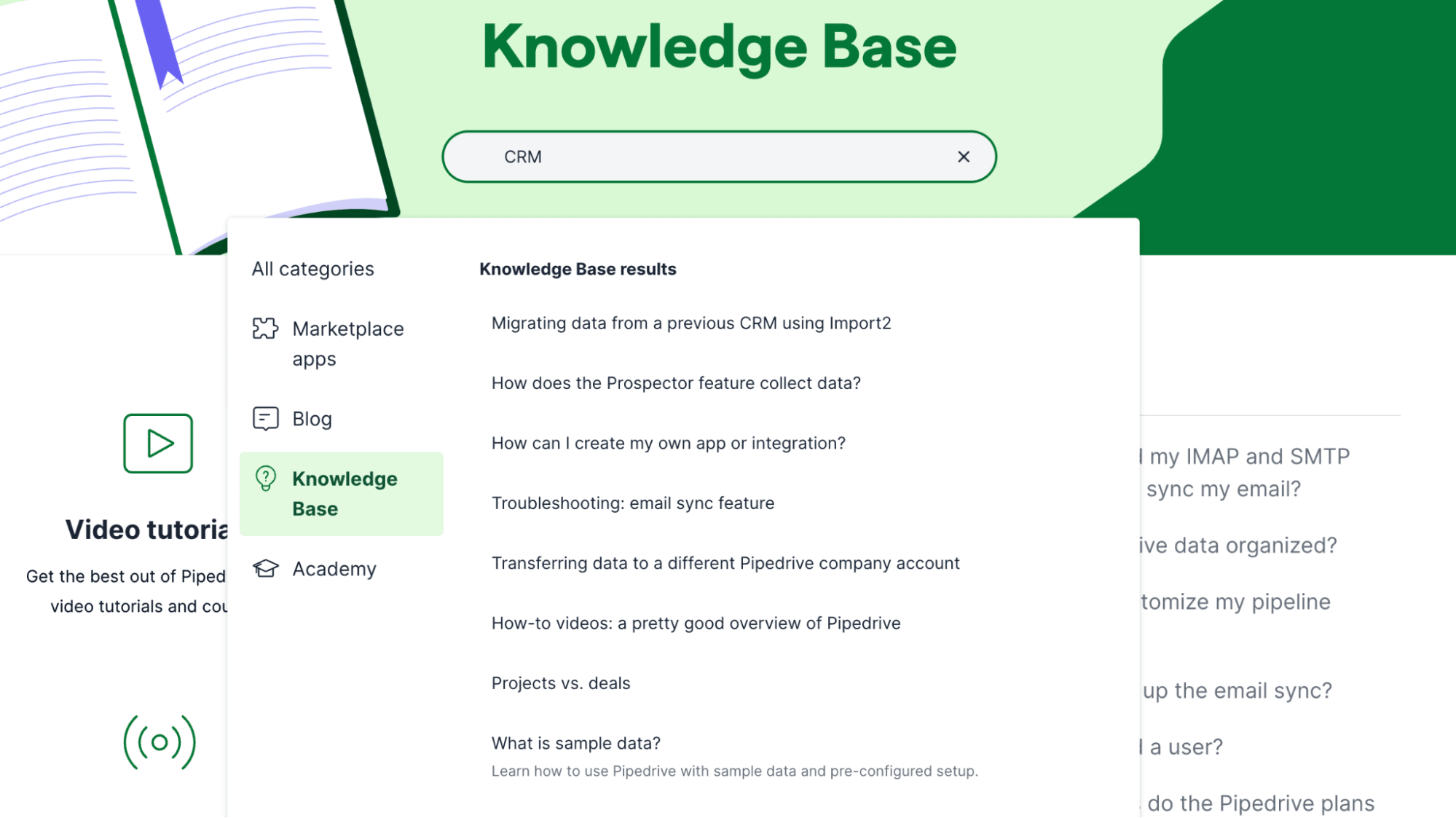
Chatbots are another self-service tool you can add to your website to meet customer needs and expectations. For instance, Pipedrive’s Chatbot can:
Handle common inquiries immediately
Point customers in the direction of relevant resources
Route more complex issues to live agents
Customize the tool to meet specific customer needs. If people visit your website to book appointments, use the following template to make it happen with a few clicks.
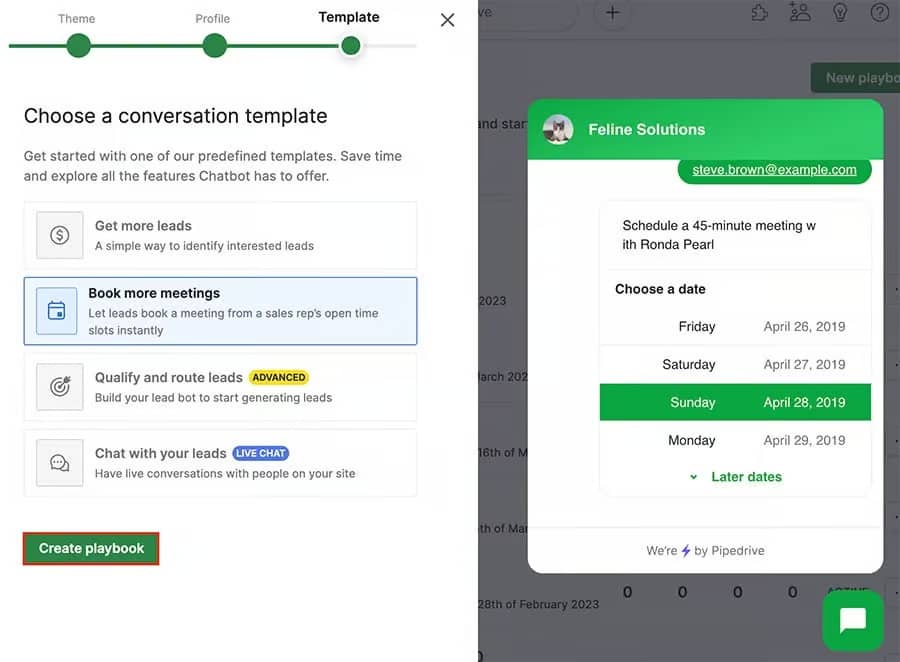
Because the chatbot connects to the broader Pipedrive ecosystem, it automatically adds contact details and interaction information to your CRM, ensuring you keep the right customer data in one place.
Chatbot is a feature of Pipedrive’s LeadBooster add-on, available on any plan from $32.50 per company per month, billed annually.
3 customer orientation examples
To see what customer orientation looks like in practice, it helps to study companies that have built their brands by putting customers first.
Everyone knows about famous customer-obsessed brands like Amazon and Zappos, but what about smaller operations? Here are three examples of customer orientation in software and startup companies.
1. ClickUp
ClickUp is a project management software provider that takes a customer-oriented approach to product development. It collects feature requests from customers and lets other users vote on them.
Here’s what the feature requests functionality looks like:
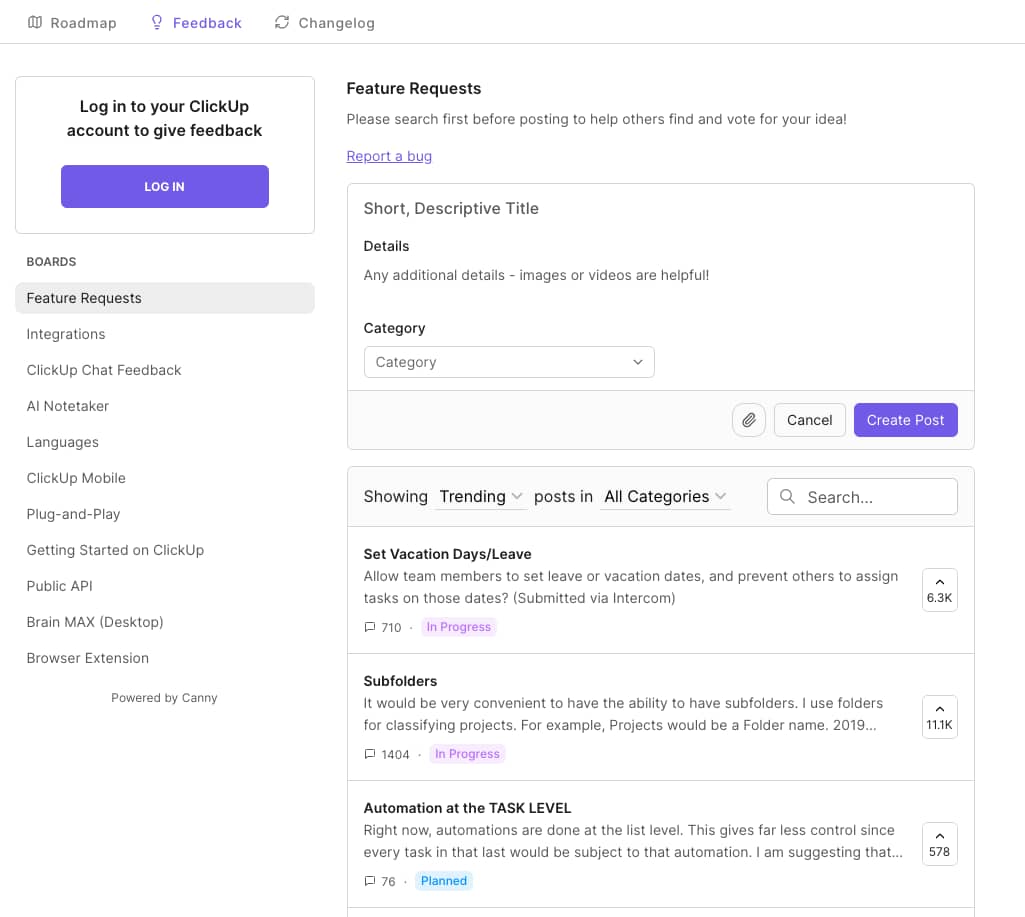
The SaaS tool also publicly shares its product roadmap so users can track the company’s progress.
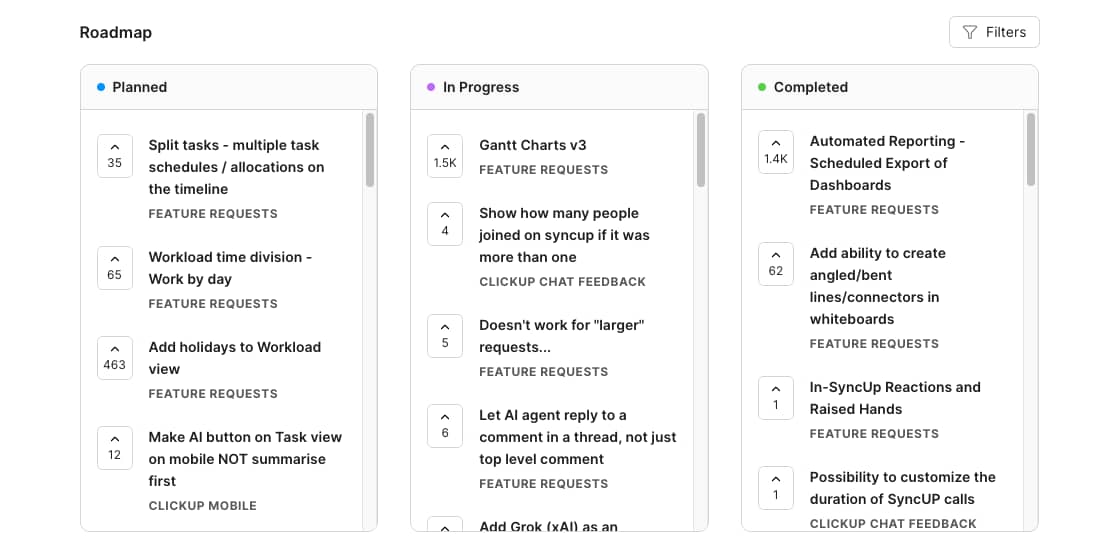
By making customers co-creators, ClickUp fosters a sense of community ownership that deepens loyalty and ensures it continues meeting customer needs.
The brand also does a great job of announcing product launches and updates through email and social media. Here’s an example:
Regular communication reassures every customer that ClickUp really listens and incorporates all feedback to improve its product in line with their needs.
2. HeyTaco
HeyTaco is a peer-to-peer recognition platform that has maintained a clear customer focus since its inception. It creates consistent, meaningful experiences at every touchpoint, celebrating and sustaining team engagement through a gamified leaderboard:
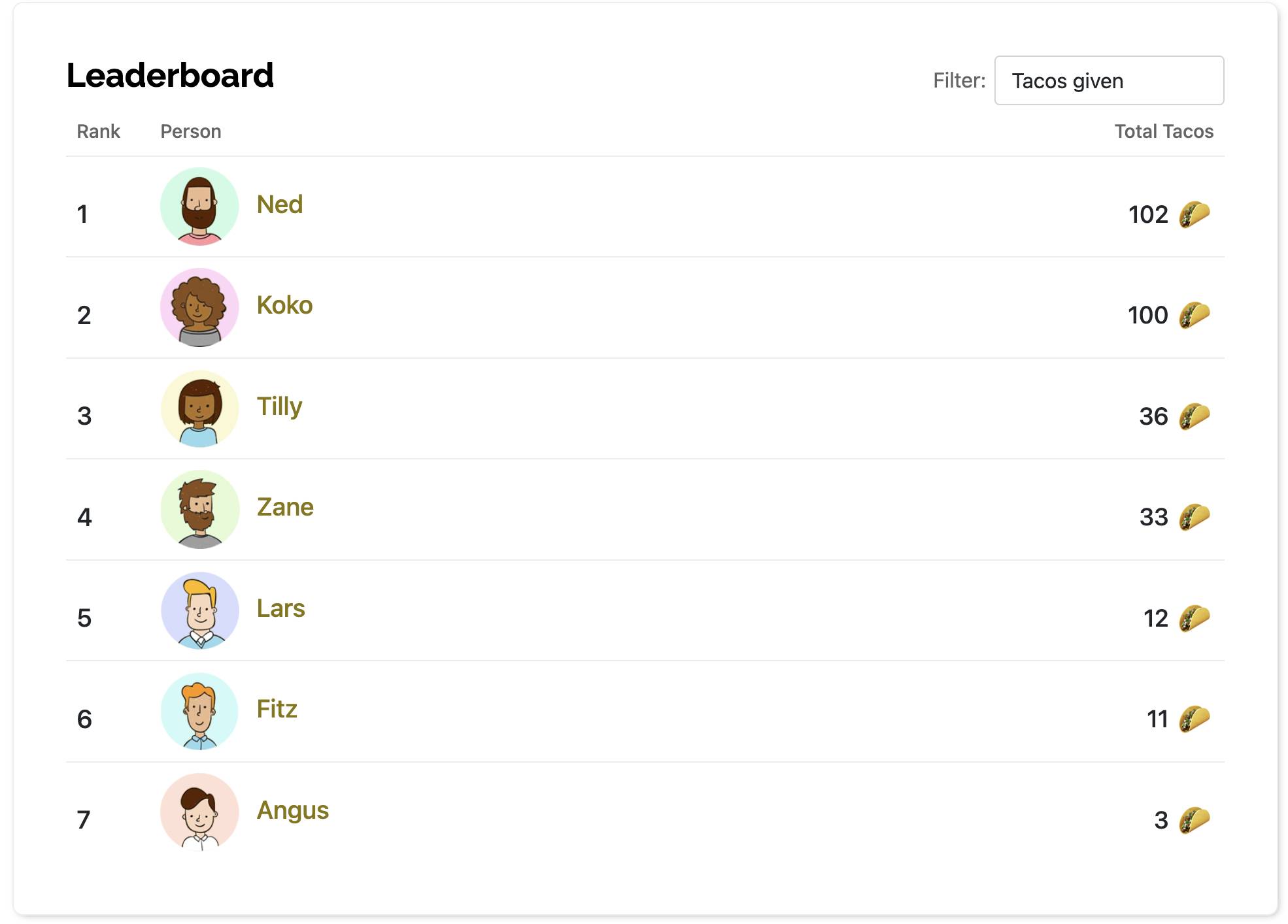
Here are a few ways the company puts customers first, according to founder and CEO Doug Dosberg:
Fast customer service response times, with an autoresponder that lets senders know they’ve received their request
Being transparent about who they are and why the company exists
Following up at regular intervals, when activity drops and they release new features
Using a CRM system to keep track of everything they learn about customers
Sending handwritten thank-you cards to every new customer

HeyTaco’s philosophy proves many successful ways a company can deliver customer value by building genuine human connections throughout the buyer’s journey.
3. DashThis
At DashThis, a company that provides reporting dashboards for marketers and agencies, delivering an outstanding experience starts with account management.
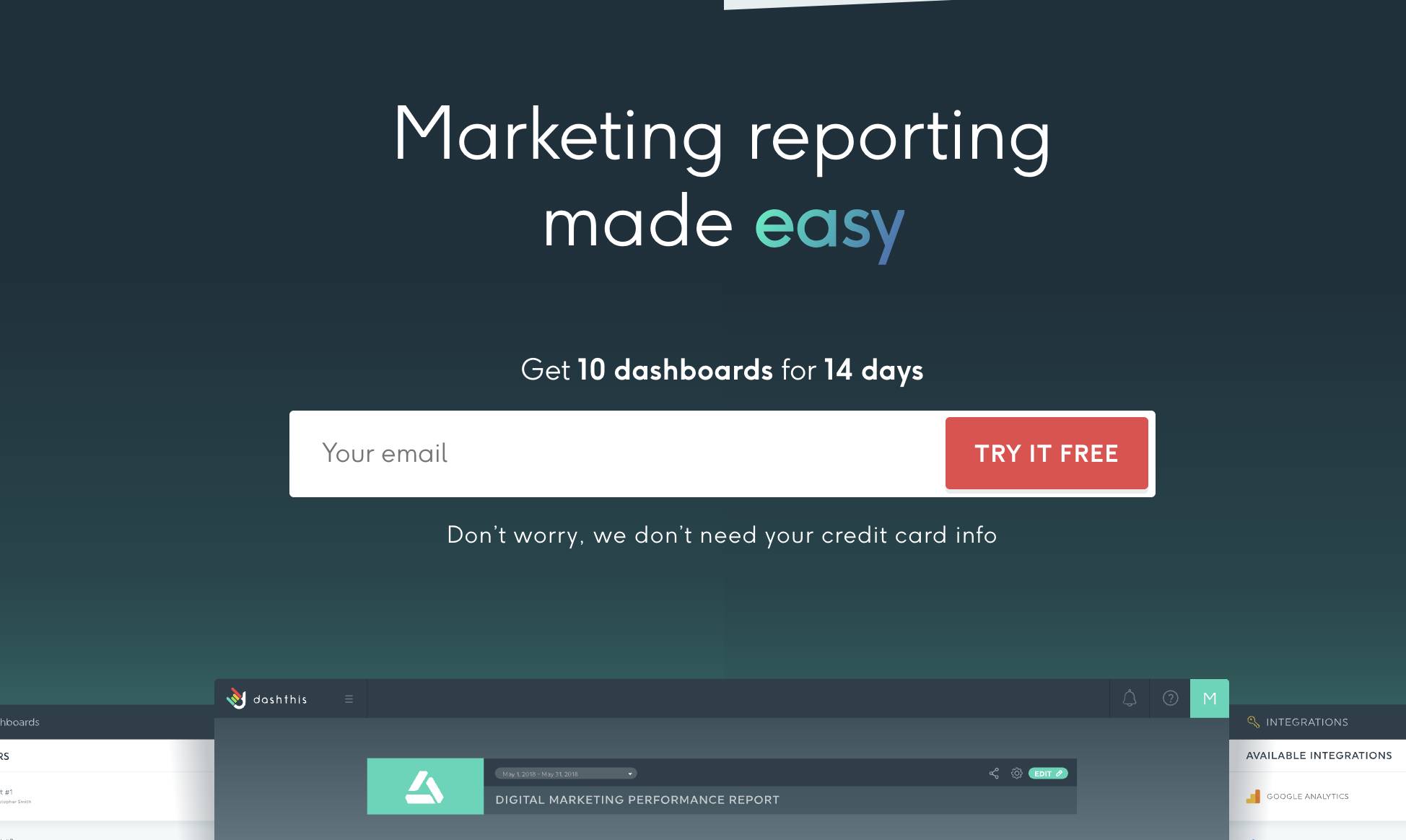
As founder Stéphane Guérin explains:
When it became hard for account managers to stay organized as the company grew, the team adopted Pipedrive’s CRM.
The CRM’s customized workflows make it easy for account managers to complete tasks and ensure no leads are left behind.
As Gabriel, a DashThis account manager, explains:
It also increases communication between account managers, letting them share information so that every customer gets the same great experience.
Final Thoughts
Customer orientation can happen much faster than you think. While making your entire company customer-centric may take time, you can immediately start putting buyers at the center of your decisions.
A tool like Pipedrive accelerates the process by centralizing customer data and delivering AI-powered personalization.
Start your 14-day free trial to create exceptional customer experiences without overloading your team.






